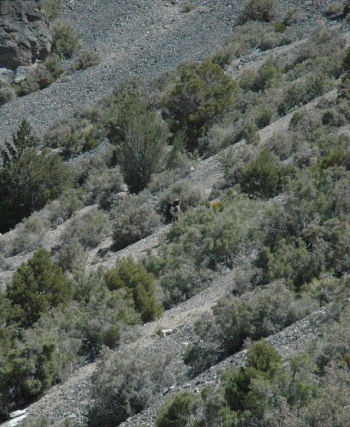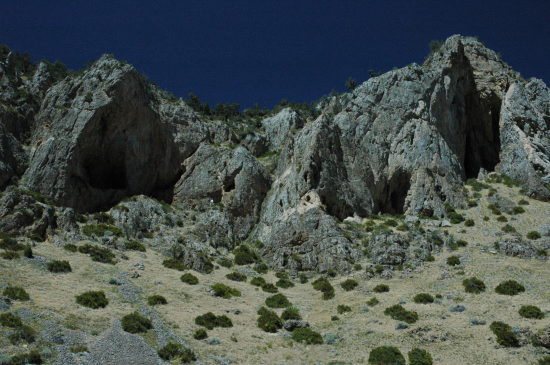Cave exploration in the western mountains

Anthony Smith struggling up a scree mountain slope.
I have only visited Nevada twice before, and those visits had been limited to the area around Las Vegas. Thus, my impression of the state had been similar to what most other people assume: a big ostentatious urban city surrounded by boring flat deserts.
Instead what I found is that Nevada is probably one of the most beautiful states in the nation. It has many mountain ranges, interspersed with wide flat valleys, a number of which have lakes or swampy areas because the water is trapped there, draining neither to the Pacific or Atlantic.
Yet, it is desert country. The limited amount of water means that the state is lightly populated, and the few farms or ranches that you pass actually act to amplify the feeling of emptiness. This is further enhanced by the frequent mountain ranges. Every time you cross over a range, you find yourself high in the air with a spectacular view of the vast valleys below.
The Forest Service job that I was part of this past week was focused on inventorying and surveying a number of known caves covering a large area in northeastern Nevada. The work had actually started several years earlier, so that this particular week was the final wrap up, mapping the last few known caves on the list while also ridge-walking several different canyons in an effort to find some new discoveries.
None of this work was easy to reach. Unlike the east, where you can usually park relatively close to the cave and spend most of your trip exploring the cave itself, in the west the caves are smaller and the country is vaster and more remote, so that most of the experience involves a great deal of hiking just to get to the cave entrance.
Moreover, the methods of finding new caves is very different. In the east new cave passages are usually found by digging either inside a known cave or following the surface water drainages and digging either where water sinks into limestone bedrock or reappears at a spring. And you generally have to dig, because most of the easy-to-find entrances have long-ago been discovered.
In the west, there rarely is enough water to produce a flowing stream. Caves are formed differently. Moreover, there is rarely a need to dig into a cave, as the majority of easy-to-enter caves have simply not yet been found.
Instead, you literally need to walk the entire mountainside, looking continuously for holes that might be a cave entrance. And because of the vastness of the land as well as its remoteness, there are giant swathes of territory that have never been checked. To check them out, however, requires a determination and single-mindedness that most people do not have.
For example, when we weren’t surveying a known cave this past week, we were tramping up the sides of mountains — with elevation gains of anywhere between 300 and 1,800 feet — and poking our heads into the various holes that we had spotted by binoculars from below.
Discovery is never easy. For every hundred small holes you look at, you might find one new cave of note or significance — and only if you are lucky. For example, on Monday I and three other cavers, Anthony Smith, Jim Rolf, and Bruce Lynn, worked our way along the base of a cliff high on a mountainside, surveying a string of spectacular holes that had been identified during a previous work week. As you can see from the picture below, all the holes seemed very tempting, any one of which might have been the entrance to a significant cave.

Bruce is the white speck in front of one of the smaller holes a bit left of center.
Unfortunately, none were. All ended up to be shelters, the deepest extending into the mountainside only about seventy feet. And instead of beautiful cave formations, we found a lot of animal bones and pack rat poop. (This poop is interesting, however. The rats will urinate repeatedly in the same spots, and when the urine dries it leaves behind a thin deposit. Over time these deposits will pile up and form something called amber rat, a dark reddish material that will often flow down the sides of walls and produce formations resembling cave flowstone and stalactites.)
This is the reality of exploration. Most of the work will produce nothing. The one discovery I mentioned earlier in the week turned out to be far less interesting when we went back to survey it. Oh well.
You keep pushing, however, because eventually there will be a pay-off, and when it happens, you will have the joy of seeing something no human has ever seen before.
And in the case of Nevada, as well as much of the west, the potential is gigantic. There is just so much unexplored territory, and too few people to check it all out. Hidden in those mountains are certainly many undiscovered caves, waiting only for the person with the determination and patience to do the work to find them.
On Christmas Eve 1968 three Americans became the first humans to visit another world. What they did to celebrate was unexpected and profound, and will be remembered throughout all human history. Genesis: the Story of Apollo 8, Robert Zimmerman's classic history of humanity's first journey to another world, tells that story, and it is now available as both an ebook and an audiobook, both with a foreword by Valerie Anders and a new introduction by Robert Zimmerman.
The print edition can be purchased at Amazon or from any other book seller. If you want an autographed copy the price is $60 for the hardback and $45 for the paperback, plus $8 shipping for each. Go here for purchasing details. The ebook is available everywhere for $5.99 (before discount) at amazon, or direct from my ebook publisher, ebookit. If you buy it from ebookit you don't support the big tech companies and the author gets a bigger cut much sooner.
The audiobook is also available at all these vendors, and is also free with a 30-day trial membership to Audible.
"Not simply about one mission, [Genesis] is also the history of America's quest for the moon... Zimmerman has done a masterful job of tying disparate events together into a solid account of one of America's greatest human triumphs."--San Antonio Express-News


No snakes?
Sounds like you had some fun. When you spoke of digging for caves here in the east, you made it sound easy. While it’s true that for the most part you can drive to within a mile or less of the dig site (often much less), you didn’t mention that most digs turn up nothing. Even most successful digs don’t discover big, significant caves. It’s quite rare to find caves like Memorial Day, BZ, or Shovel Eater. Anyway, I hope you had a great time, and I hope you got into some virgin cave.
No snakes. Though one must keep an eye out for rattlers, they aren’t as common as most people assume.
That is good to know. Thanks for the updates, this isn’t something people get to read about often.
Thanks for sharing your experience. It was always my childhood dream to jump into a cave adventurously and dig up precious minerals. Seems you had a blast. I’ll bookmark your blog for more informative articles. Keep up the good work!
Going into a cave is cool. Going into a cave to dig up minerals is not okay. Most cave formations are protected by law. More importantly, they are protected by cavers. If you even hinted that you wished to do this then cavers are not going to take you places.